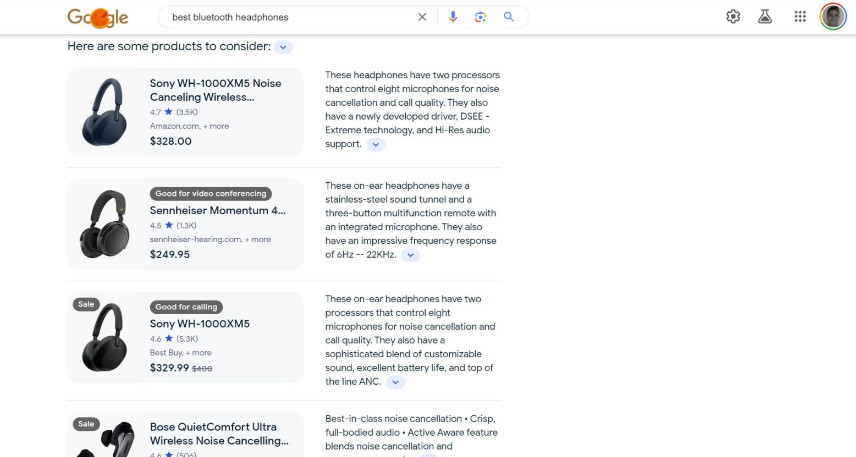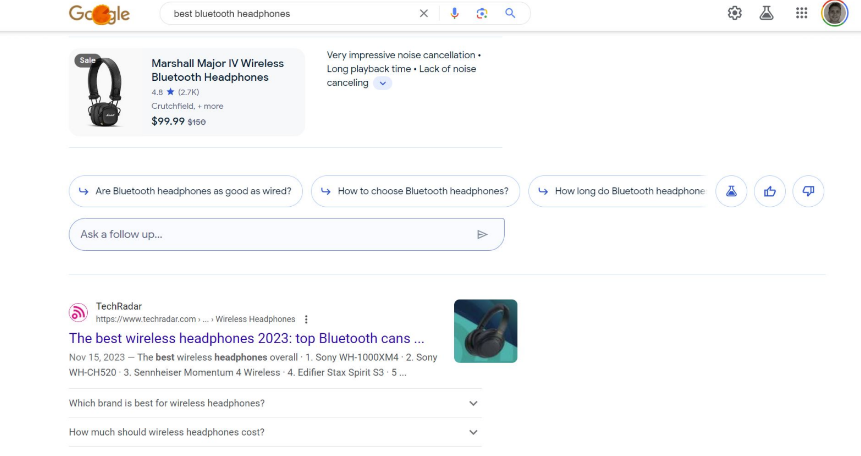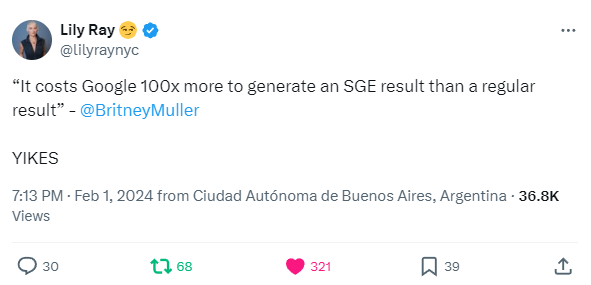Google SGE (AI Overviews) & SEO – The complete guide

Frederik Stilund Drost
Senior SEO Solutions Engineer
Introducing: ✨Google’s Search Generative Experience (SGE): Insights, Optimisation, and Challenges✨
Google’s Search Generative Experience (SGE) marks a significant shift in how users interact with search engines. As a new paradigm in search technology, SGE has the potential to reshape user experiences and SEO strategies alike.
This blog post explains what SGE is, presents key insights and data, discusses its limitations and criticisms, and offers strategies for adapting to this transformative technology.
1. What is Search Generative Experience (SGE)?
Search Generative Experience (SGE) is a revolutionary feature from Google that integrates generative AI technology into search results to provide dynamic, expanded content directly within the search interface.
By combining machine learning algorithms and vast data repositories, SGE can generate comprehensive, contextually relevant answers that appear prominently on the search results page.
What is Retrieval-Augmented Generation (RAG)?

Retrieval-augmented generation (RAG) is a method where a system finds and uses relevant information to help a language model give better answers. It’s a mechanism by which a language model can be “grounded” in facts or learn from existing content to produce a more relevant output with a lower likelihood of hallucination.
2. SGE by the numbers
- Appears in 87% of searches
- 66% show a “Generate” button
- 34% show a snippet with an expand option
- SGE can take up 150 % of the screen height
- Avg. 10 links from 4 different domains.
- Mostly links are not in the top 10 in Google for the given query, but for other queries.
The largest generative content introduced 37 new visible URLs above the organic rankings!
Important note: Many different studies suggest different numbers, as SGE is still in beta for many and is not fully rolled out to the public. I recommend you check out this summary of all the current SGE studies, to get a better overview.
3. Examples of SGE results
“Best [product]” searches
It starts with generic advice on what to consider, with articles to the left that are related to the topic:

We then get actual products! This is where brands and shops should try to be (more on how later in this guide).

Finally, we end with some follow-up questions or the possibility to ask one yourself.

Google seems to want to guide you through a customer exploration journey without leaving Google 🫣
The same goes for more direct product searches, where the SGE results look quite similar with less information, as the user has already passed the exploration point, and almost know what they want:

Informational searches
The key takeaway from the top of this SGE result is that there is also an image in the form of an infographic!

After that, we see some tips and follow-up questions.

We get another SGE result below if we press the follow-up questions.

Again, it seems like Google wants to guide you through a funnel faster, with each exploration step being on Google, with the option to leave for further exploration.
4. Criticism and limitations
Despite its innovative approach, SGE has faced its share of criticisms.
Quality concerns
There have been instances where SGE results have been less than accurate, leading to misinformation. This is particularly troubling in fields like medical or financial advice.
See this example shared by Lily Ray on X, where SGE recommended Spam Sites.
See also this example shared on X:

Impact on traffic
As SGE answers more queries directly on the search results page, websites may experience a significant drop in traffic, which could impact ad revenues and engagement metrics.
Market skepticism
Some experts believe that SGE may not be a permanent fixture in Google’s arsenal, given the mixed responses from users and marketers alike.

Quoting Lily Ray here: “Yikes” is the correct word.
Google will have to cache a lot of popular SGE results. This could affect the “freshness” of the results.
5. How to rank in SGE?
To stay ahead in a world where SGE could become a norm, businesses and content creators need to adapt their SEO strategies:
Risk assessment

Before even worrying too much about SGE, doing a risk assessment can help decide how much you need to worry and focus on optimising for SGE.
You can use this free tool to visualise how SGE could possibly see and use your content in an AI-powered response.
Good SEO
Luckily, doing good white-hat SEO will cover most of the tips for optimising for SGE. I won’t go through all the details of what makes a good long-term white-hat SEO strategy.
Enhance structured data
There is evidence that structured data plays a large role in training LLMs and also helps them retrieve information. Implement structured data thoroughly across your site to help Google understand and retrieve information more effectively for SGE.
Focus on quality content
Ensure content is not only SEO-friendly but also rich in information and easy to parse by generative AI, which prefers concise, well-structured answers.
Use visuals and media
Since SGE can also display videos and images, incorporating these into your content strategy might increase visibility.
Enhance EEAT signals
Make sure you show Google your expertise and experience and the people who writes your content (using author profiles).
Get into Google Knowledge Graph
Make sure you display contact and business information on your site, and link to those pages from social media profiles. Essentially, be out there !
Use Google Merchant Center
Besides referencing content from Google’s index, Google Shopping Graph also uses Google Merchant Center, which Search Generative Experience then uses when generating its AI-powered results.
Monitor and adapt
Keep a close eye on how SGE is evolving and continuously tweak your strategy to align with the latest changes and best practices. See what ranks and adapt to that, like creating a category for a type of relate response you see on queries you would like to be on.
6. Think in new terms
Search Experience Optimisation (SXO) is an evolution of traditional search engine optimisation (SEO) that focuses on enhancing the user experience specifically tailored to the platforms where the target audience is most active.
This shift requires an understanding of user behaviours on platforms like TikTok, Instagram, and Pinterest, and involves creating content that is meticulously designed to engage users within these and similar ecosystems.
The goal of SXO is to optimise both the in-platform experience and the content to improve user interaction and satisfaction. As digital environments like Google’s SERPs evolve to include a more diverse and dynamic content blend, including entries from platforms like TikTok, SXO becomes increasingly vital.
This approach emphasises the importance of balancing AI-generated content with personal insights to maintain authenticity and underscores the necessity of building a strong brand presence to ensure visibility and growth in the face of changing algorithms.
Conclusion
Google’s Search Generative Experience is setting the stage for the next big shift in online search. While it presents new challenges, particularly in terms of SEO and traffic dynamics, it also offers opportunities for those who can quickly adapt to its mechanisms.
By understanding SGE’s functionality, actively monitoring its impact, and optimising content to leverage this new technology, businesses can navigate these changes effectively to maintain visibility and relevance in the new age of search.
In conclusion, as we continue to witness the integration of AI into every aspect of digital interaction, staying informed and agile will be key to leveraging technologies like SGE to our advantage.


